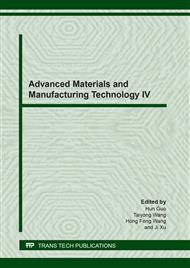[1]
Z. K. Zhao, F. Z. Ding, H. L. Qian. Metal materials and heat treatment technology[M], Beijing: National Defense Industry Press,(2011).
Google Scholar
[2]
J. A. Liu. Key technology of aluminum production[M], Chongqing: Chongqing University press, (1997).
Google Scholar
[3]
F. S. Pan, D. F. Zhang. Aluminum alloy and its application[M], Beijing: Chemical Industry Press, (2006).
Google Scholar
[4]
J. D. Liu. Study on Microstructure and properties of soft contact electromagnetic continuous casting 7050 aluminum alloy[D], Dalian: Dalian University of Technology, (2009).
Google Scholar
[5]
L. Gu. Several common problems in metallographic examination of hard aluminum alloy[J]. Journal of Gansu Normal Colleges, 2005,10(2): 29-30.
Google Scholar
[6]
J. F. Li, Z. J. Zheng. The role of second phase in localized corrosion of aluminum alloys[J]. Materials Review, 2005, 19(2): 81-83.
Google Scholar
[7]
C. Y. Liu, D. C. Zhou, C. A. Li, J. M. Li. Effect of heat treatment process on Microstructure and properties of 2A14 forgings[J]. Material & Heat Treatment, 2009, 38(24): 148-150.
Google Scholar
[8]
X. Yang. Study on ultimate heat treatment of Al-65Zn-2.4Mg-2.3Cu ultra high strength aluminum alloy thick plate[D]. Liaoning: Northeastern University, (2009).
Google Scholar
[9]
Z. T. Wang, R. Z. Tian. Aluminum alloy and its processing manuals[M], Changsha: Central South University Press, (2000).
Google Scholar
[10]
S. Z. Song. Corrosion electrochemical methods[M], Beijing: Chemical Industry Press,(1998).
Google Scholar
[11]
H. W. Liu, K. H. Chen, Y. Z. Liu. Effect of strengthening solution on Microstructure and properties of 7050 aluminum alloy[J]. Metal Heat Treatment, 2000, 27(9): 16-17.
Google Scholar
[12]
S. L. Zhang, S. Z. Ren. Concise Application Manual for aluminum alloy[M]. Shanghai: Shanghai Scientific and Technical Literature Publishing House, (2006).
Google Scholar
[13]
S. S. Xie, J.A. Liu, G. J. Huang. 500 questions on aluminum processing technology[M], Beijing: Chemical Industry Press,(2006).
Google Scholar
[14]
J. A. Liu, S. S. Xie. Application and technology development of aluminum alloy materials[M], Beijing: Metallurgical Industry Press, (2004).
Google Scholar
[15]
Y. M. Wang. Metallographic and electron microscopic observation of microstructure of wrought aluminum alloy[C]. Industrial Aluminum Profile Technology Collection, 2006, 34-52.
Google Scholar


